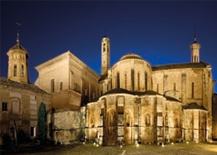
Locality: FITERO (31593)
Address: Plaza Plaza de la Iglesia, 12
Zone: The Ribera
Style: Others
Centuries of construction: XII
Tel.: 948776600
History
Would you like to get to know the first monastery that the Cistercians built in the Iberian Peninsula? Lose yourself between its walls, raised between 1185 and 1247 and extended in the 16th and 17th centuries? Enjoy a place that was coveted by monarchs, Popes, bishops and lords for centuries?
It is in Fitero, a small town in the southwest of Navarre almost on the border with La Rioja. It was declared a National Monument in 1931. The grandiose dimensions of the monastery, an architectural jewel of the Middle Ages, will surprise the visitor.
Its abbey church is one of the most important of the Cistercian Order in Europe. Its interior conserves an extensive collection of Arabic chests, medieval jewel cases and a beautiful Gothic reliquary made from enamel from Limousin.
Fitero
The monastery is also a good starting point for pleasant walks around the surrounding area or a visit to take the waters of the spa at Fitero, three kilometres from the town.
The monastery is located inside the town of Fitero, in the southwest of Navarre in the valley of the river Alhama, 23 kilometres from Tudela.
Although the town was initially distant from the monastery, Fitero was repopulated in the 15th century to strengthen the defences of Navarre and the new houses were built around the abbey, converting Fitero into one of the few Cistercian monasteries that are actually inside a town.
Description
The monastery, declared a National Monument in 1931, was founded in 1140 although building work on the different parts did not start until 1185. Some of these parts now have non-religious functions: the hospice is the Town Council building, the cells were reconverted into a residential home for the elderly, the refectory is the town’s Casa de Cultura and cinema, and the library and the kitchen were turned into a museum.
The visit reveals medieval sections from the 12th and 13th centuries such as the Latin cross abbey church with three naves and an apse aisle header with five chapels, making it a unique example of a Cistercian monastery in Spain. There are medieval remains in the walls of the library, vestiges of the ancient wall and the chapter house, constructed in 1247. You will also be surprised by the square Renaissance cloister and the rooms above it, constructed in the Herrerian style of the 16th century.
Other notable sections of the monastery are the new dormitory (16th century), the abbot’s palace in the Manierist style of the 16th century, which was extended in the 17th, and the library (1614).
Among the examples of silversmithing conserved in Fitero are the reliquary arm of San Raimundo, the founder of the monastery; the reliquary-communion chalice of San Andrés (18th century), other chalices from the 17th, a silver and shell chalice (16th), a ciborium of filigree silver (17th), an ebony chest dated 966, a small enamel pyxis (box) from 1200, three small arches made of ebony plate and wood from the 11th, 12th and 13th centuries, and the main altar piece painted by Rolan Mois (16th century).
Walks
Fitero is also the starting point of pleasant walks, such as the 7.7-kilometre Cruza de Atalaya (watchtower cross) that starts at the top of the town near the football ground, or the 8.2-kilometre Circuito de Roscas that starts at the crossing of the roads that leave Fitero towards Cascante and Valderde. The second road passes by the ruins of the Arabic castle of Tudején and the nevera de los frailes, an enormous stone well in the middle of an olive grove that the monks used to store snow, and the cueva mora, a cave where, according to the legend narrated by Bécquer, the soul of an Arab princess appears every night in search of water for her beloved Christian.
The spa of Fitero is worth a visit, its waters being particularly recommended for sufferers of rheumatism, arthrosis and asthma. Another place of interest is the mojón de los Tres Reyes (Boundary Stone of the Three Kings) on the road from Madrid three kilometres from Valderde. It was the scene of meetings of the monarchs of the kingdoms of Navarre, Castile and Aragon, in which each could speak from his or her own territory, and eat at the same time!







